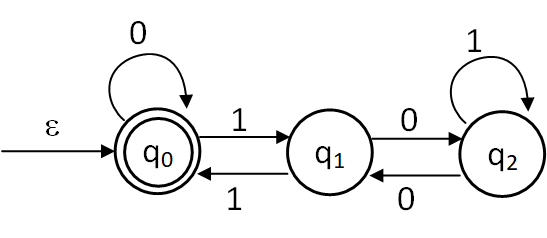challenge - binary multiple of 3
the challenge was to create a regular expression capable of recognizing multiples of 3.
Challenge
After I run my marathon I took some days to rest by the sea. Little did I know that instead of a conventional boat I would embark on a computational odyssey where on a sea of zeros and ones. It happened when I crossed paths with this CodeWars kata. It seemed simple, since I only had to create a regex expression. And it had a hight reward - 4 kata. So, I decided to take a try. After all, I just had to find a pattern amidst the cascade of 0s and 1s of the binary numbers multiple of 3.
In this kata, your task is to create a regular expression capable of evaluating binary
strings (strings with only 1s and 0s) and determining whether the given string
represents a number divisible by 3.
Take into account that:
An empty string might be evaluated to true (it's not going to be tested, so you don't
need to worry about it - unless you want)
The input should consist only of binary digits - no spaces, other digits, alphanumeric
characters, etc.
There might be leading 0s.
Journey
I started by writting a bunch of binary representations of multiples of 3, in the hope of finding a pattern visually.
| Decimal | Binary |
|---|---|
| 3 | 11 |
| 6 | 110 |
| 9 | 1001 |
| 12 | 1100 |
| 15 | 1111 |
| 18 | 10010 |
| 21 | 10101 |
| 24 | 11000 |
| 27 | 11011 |
| 30 | 11110 |
There is one, but I wasn’t able to recognize it, but a quick search on the internet showed me that if I sum all the odd-positioned bits and subtract to it the sum of all of the even-position bits and get a result that is divisible by 3, then the original binary number is also divisible by 3.
27 in binary is 11011
odd bits: 1+0+1 = 2
even bitts: 1+1 = 2
different: 2-2 = 0, hence 27 is divisible by 3.
Converting this logic to a regular expression is not straightforward, they work well for pattern matching and not for mathematical operations. So, it hit me. I could use an Automata. The Automata would have states representing the remainder when divided by 3 (the possible remainders are 0, 1 and 2), and transactions based on the next binary digit. And we could then determine the divisibility by 3 by observing the state after processing all the bits.
With the available info it is easy to design the following DFA

We could directly write a regular expression from this DFA, bur we can do better than that. We start by defining it mathematically
Given the DFA \(( M = (Q, \Sigma, \delta, q_0, F) )\), where:
\[( Q = { q_0, q_1, q_2 } ) ( \Sigma = { 0, 1 } ) ( \delta )\]is defined by the transitions:
\[\begin{aligned} \delta(q_0, 0) &= q_0 \\ \delta(q_0, 1) &= q_1 \\ \delta(q_1, 0) &= q_2 \\ \delta(q_1, 1) &= q_0 \\ \delta(q_2, 0) &= q_1 \\ \delta(q_2, 1) &= q_2 \end{aligned}\]\(( q_0 )\) is the start state
\(( F = { q_0 } )\) is the set of accept states
Then we can start by writting the equations for all the states:
\[q_0 = \epsilon + q_0 0 + q_1 1 q_1 = q_0 1 + q_2 0 q_2 = q_1 0 + q_2 1\]To simplify \(q_2\) and \(q_1\) we can use Arden’s theorem. We first note that the theorem states that if a regular expression \(R\) satisfies the equation \(R = Q + RP\), where \(Q\) and \(P\) are regular expressions and \(P\) does not contain the empty string \(\epsilon\) then \(R = QP*\) is a solution for the equation.
Applying it to \(q_2\) we get \(q_2 = ( q_1 0 ) ( 1 * )\) - this represents the language accepted by \(q_1\) followed by a 0 and then any number of 1s.
Now substituting this on the equation for \(q_1\) we get \(q_1 = q_0 1 + ( q_1 0 ) (\ 1 * ) 0\).
We can now apply Arden’s Theorem again: \(q_1 = ( q_0 1 ) ( 0 ( 1 * ) 0 ) *\) - and you get the language accepted by \(q_0\) followed by a 1 and then any number of repetitions starting with 0, followed by zero or more 1s and ending with 0.
Now we can write \(q_0 = \epsilon + q_0 0 + q_0 1 ( 0 ( 1 * ) 0 ) * 1 = \epsilon + q_0 ( 0 + 1 ( 0 ( 1 * ) 0 ) * 1 )\).
Applying Arden’s Theorem again we get:
\[q_0 = ( \epsilon ) ( 0 + 1 ( 0 ( 1 * ) 0 ) * 1 ) *\]That can be further simplified to
\[q_0 = ( \epsilon ) ( 0 + 1 ( 0 ( 1 * ) 0 ) * 1 ) *\]This is the final expression for \(q_0\) that describe all the strings accepted by the automata that start and end in this state.
Solution and reflection
const std::string multiple_of_3_regex = "^(0|1(01*0)*1)*$";It’s fascinating how theoretical computer science principles blend into practical programming challenges. It’s a vivid reminder that beneath every line of code lies a rich tapestry of logic and mathematics, waiting to be explored and appreciated. Every challenge is not just a test of skill, but an invitation to an intellectual adventure, revealing the interconnectedness of concepts we sometimes take for granted.